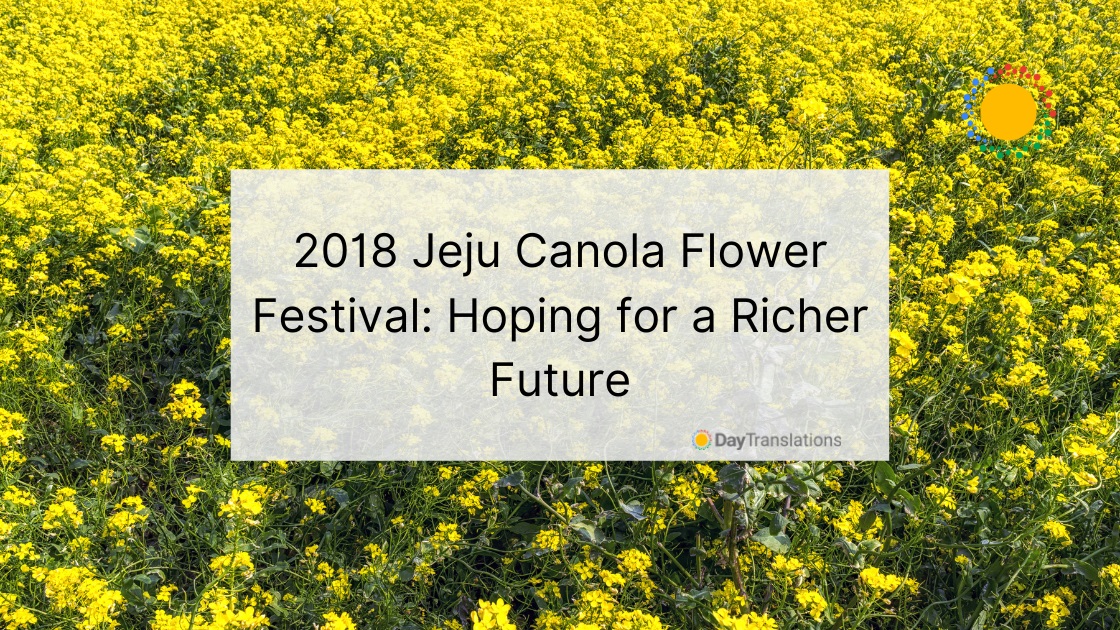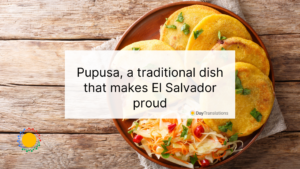Spring brings new hopes, new beginnings and a multitude of colors from a myriad of flowers opening their sleepy heads to the season. At Jeju Island in South Korea, you can literary walk through a sea of yellow, bright sunshiny yellow flowers that is, from acres upon acres of canola fields in bloom.
With a fantastic Jeju landscape framing the fields, the imposing mystical Mt. Sanbangsan and other attractions in the area, visiting Jeju at this time of the year is something that you should not miss.
From April 7 to 15, 2018, Jeju Island celebrates the 36th Jeju Canola Flower Festival. It’s one of the most famous among the festivals in Jeju. The festival only runs for a few days. Hoping for a prosperous future is this year’s theme. Several activities and outdoor experiences are lined up for local and international visitors to the festival.
There are performances such as the Canola Music Festival and the Canola Singing Contest within the canola fields. Visitors can go horseback riding, hiking, walking and running along the lanes near the flower fields. They can experience hands-on traditions such as cooking pan-fried flower rice cake, creating canola crowns from fresh canola flowers, making mugs and handkerchiefs, flower diffusers, air fresheners and cooking bingtteok (Jeju buckwheat pancake).
The Canola flower
Spring in South Korea is heralded by the blooming of several plants and trees, including lotus, cherry and canola. In Korean, the canola flowers are called yuchae.
Canola is a plant that was developed in Canada. Rapeseed, which closely resembles canola, was used to make fuel in ancient times and was used to produce cooking oil. However, human consumption of rapeseed oil was banned by the FDA in the mid-1950s because it contained glucosinolates and erucic acid that were toxic to humans.
Using traditional methods of breeding, Canadian researchers were able to produce a different plant from carefully chosen rapeseed varieties, without the toxic elements. The new plant was given the name canola, which is a combination of can from Canada and ola which means oil. In 1970, Canola received a trademark and started a multi-billion industry.
Canola is now grown all over the world but the Canola Flower Festival is the only festival honoring the plant’s blooming season, which has been continuously celebrated in Jeju Island for the past 36 years. Luoping County in Yunnan, China started their own canola flower festival 20 years ago, although their festival starts around the last week of February up to early March.
In Jeju Island, canola plants start to show their flowers by the last week of March. The plants are in full bloom during the flower festival. The grandeur of the bright yellow flowers remains only for a few days. Once pollinated the flower petals start to drop, to be replaced by long thin pods that contain about 20 to 30 small round seeds, which are allowed to mature before harvest time. Canola oil is extracted from the seeds.
Jeju’s different culture
Jeju’s culture is very different from the mainland. In most Asian countries, the traditional culture is patriarchal. In Jeju, it is matriarchal. In fact, it is known as the home of strong women. The gathering of seafood in the waters surrounding Jeju is done by women. Jeju is famous for the haenyo or women divers.
Without using scuba gear, these strong women are able to dive repeatedly into the sea for up to five hours to gather abalone and other delicious seafood. Some of them are well into their 60s and 70s and still able to dive alongside younger women. They have become the icons of the island, and more famous than the traditional basalt statues called grandfather statues or dol hareubang.
Different names
Throughout its history, Jeju has had several names, the last of which was Tamna. Its current name, which used to be spelled as Cheju, meaning ”province across the sea” was given by King Uijong of the Goryeo Dynasty. It was only before the beginning of the year 2000 that its spelling was changed to Jeju, when the government in Seoul decided to change Hangeul’s official Romanization.
Europeans who first saw the island in the 1940s call it Quelpart, for the orange groves on Jeju. The local term for orange grove is gyul-bat and the Europeans erroneously interpreted it as the island’s name.
You are likely to encounter two separate phonetic transcriptions of the name, though. In Korean, the island is called Jejudo. If there is a hyphen, as in Jeju-do, it refers to the administrative unit of the government, the province of Jeju.
Due to its separation from the mainland, Jeju-do is South Korea’s only self-governing province, with Jeju City as its capital. It has its own set of immigration policies that differ from the mainland of the Republic of Korea. Jeju Island or Jejudo is the largest island in South Korea.
It is known for its abundance of rocks or stones (seokda), wind (pungda) and (strong) women (yeoda). It’s called an island paradise popular for not having locked gates, thieves and beggars. Jeju is also known for weaving cloths dyed naturally with persimmons. The brown clothing made from the dyed cloth is known as garot.
Isolation
For much of the history of the island, it has very little contact with the mainland, including the kingdoms that existed in Korea. Thus it developed its own unique culture that was very distinct from the traditions practiced in the mainland. It was only during the 500-year reign of the monarchs from the Joseon era that the culture of Jejudo was influenced by the political scholars sent to exile on the island.
However, during the Joseon era, the residents of Jeju were considered as foreigners. The island was mainly used for horse breeding (a cross between indigenous horses and small Mongolian ponies) and a place of exile for political prisoners.
Women became the head of the family in the province of Jeju because the men, most of them fishermen, failed to return home after fishing trips, having been lost at sea. Likewise, during the Joseon era, the men who harvested and sold abalone were taxed heavily by the Seoul government. However, the haenyo were never taxed.
Language in Jeju
It is also due to decades of isolation that the language in Jeju is vastly different from Standard Korean spoken in the mainland. Tourists are likely to encounter a few taxi drivers who speak Chinese, Japanese and English is Jeju City. But do not expect the majority of people, even those who work in the tourist industry to speak English. It’s a wise decision to write down addresses, names of destinations and phone numbers in Korean.
The type of Korean spoken by Jeju residents differs in vocabularies. The accent is quite strong as well, so it can pose a problem even if you speak Korean yourself.
Jejueo or Cheju is a Koreanic language that is mainly used by the older generation. It is a critically endangered language although plans are underway to incorporate it into the regular school curriculum. Several organizations are making efforts to revive it. According to Ethnologue, there are only about 5,000 speakers of Jeju today. If preservation efforts are not undertaken, the language might die in 20 to 40 years.
The language is also known as Jeju Saturi or Jeju bang-eon, meaning Jeju dialect. Sometimes is it referred to as Jejumal or Jeju speech and Jejueo or Jeju language.
Many consider it as a South Korean dialect, but it is in fact classified as a separate language as it is not intelligible to the dialect spoken in the mainland. Mongolian, Chinese, Manchu and Japanese languages were incorporated into the Jejueo when the island was colonized by these countries. UNESCO classified it as a separate language. There are still Korean communities in Japan that speak Jejueo.
One of the distinct differences between Jejueo and Standard Korean spoken in Seoul is the lack of honorific deference and formality. For example, in Standard Korean you would say ”annyeong haseyo” or Hello and ”ban’gapseumnida” or ([It’s] a pleasure to meet you) when you meet a person much older than you. In Jeju, you’d hear them say “ban’gapsuda,” to anyone, which roughly translates to ”Nice ta meet ya” or ”Howdy.”
Examples of vocabulary differences
Some of the words in Jejueo are archaic and have similarities with some terms used in the olden times and the languages that influenced its development.
| Jejueo | Standard Korean | English |
| hɒnjeo opseoye | hwan-yeong | Welcome |
| abang | abeoji | Father |
| eomeong | eomeoni | Mother |
| hareubang | halabeoji | Grandfather |
| halmang | halmeoni | Grandmother |
| ajeubang | samchon | Uncle |
| ajeumang | imo | Aunt |
| orabang | hyeong | Older brother |
| gɒreul | garu | Flour, powder |
| gɒseum | gām | Stuff, material |
| yagaegi | mok | Neck |
| taeyeok | jandi | Grass |
| songki | yachae | Vegetable |
| nang | namu | Tree |
| jisil | gamja | Potato |
| gangsaeng-i | gang-aji | Puppy |
| gonaeng-i | goyang-i | Cat |
| ging-i | ge | Crab |
| saeng-i | sae | Bird |
| gasa | usan | Umbrella |
| buru | sangchu | Lettuce |
Our human translators here at Day Translations, Inc. are all native speakers of the languages we work with. They understand cultural, grammatical and lexical differences of a language and apply the rules in the projects they handle. Give us a call at 1-800-969-6853 or send us a message using out contact us form when you need accurate translation from and into Korean or any other language. Our translators, who are located around the world, are ready to serve you at a moment’s notice. Day Translations is open 24/7 so you can quickly connect with us anytime. Alternatively, download Terpy from iTunes or Google Play and install it on your tablet or mobile phone to quickly access Day Translations and request a quote.














Sorry, the comment form is closed at this time.